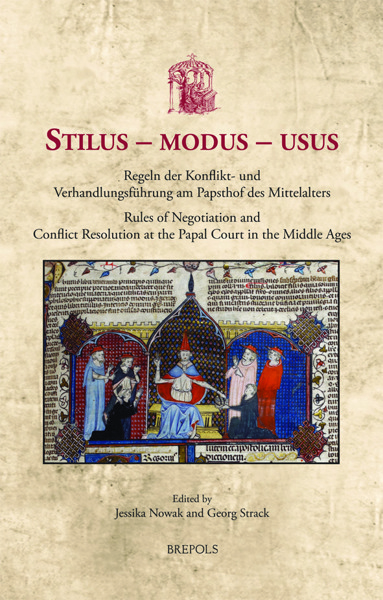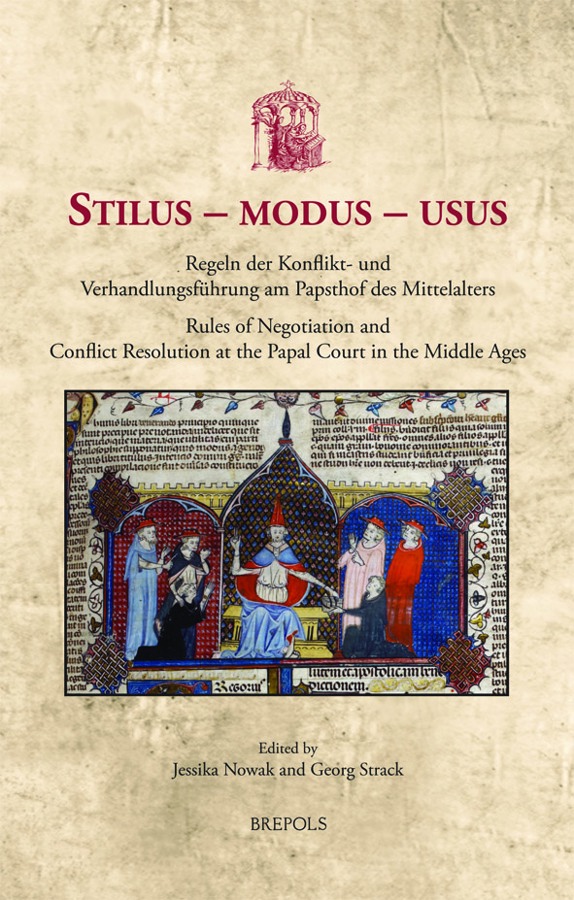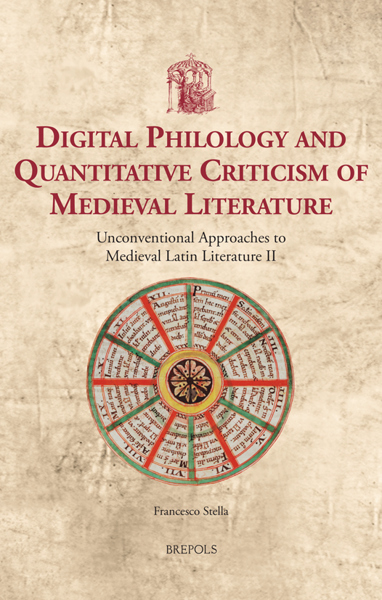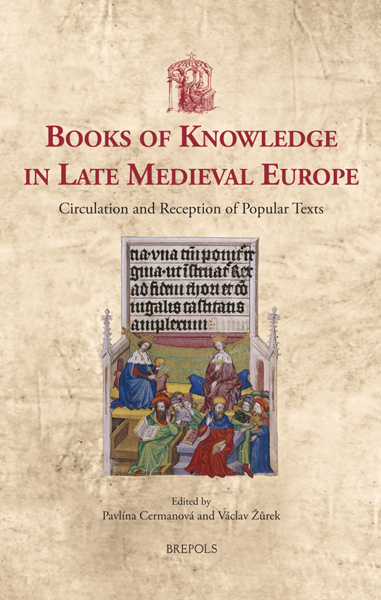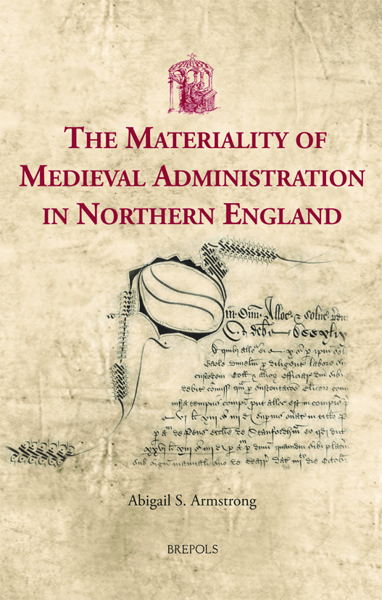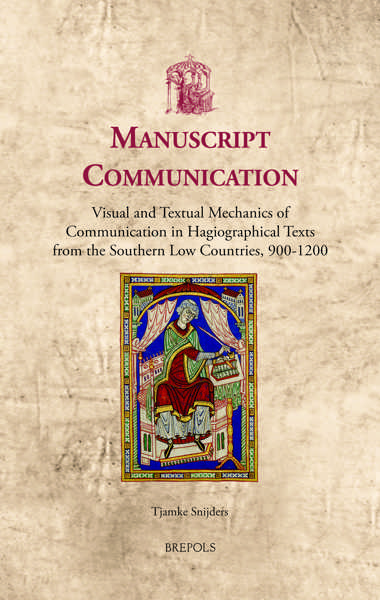
Stilus – modus – usus
Regeln der Konflikt- und Verhandlungsführung am Papsthof des Mittelalters / Rules of Negotiation and Conflict Resolution at the Papal Court in the Middle Ages
Jessika Nowak, Georg Strack (eds)
- Pages: viii + 351 p.
- Size:156 x 234 mm
- Language(s):German, English, Italian
- Publication Year:2019
- € 100,00 EXCL. VAT RETAIL PRICE
- ISBN: 978-2-503-58507-9
- Hardback
- Available
- € 100,00 EXCL. VAT RETAIL PRICE
- ISBN: 978-2-503-58508-6
- E-book
- Available
Explores communication and social practices employed during negotiations at the papal court to shed light on a wide range of sources for studying the high and late medieval papacy.
“Durchaus positiv fällt die Bewertung des Sammelbandes aus, denn er überzeugt durch die Bandbreite und Qualität der Beiträge, die eine Vielzahl an Informationen und Anregungen zum Themenkomplex stilus curiae liefern.” (Étienne Doublier, dans Francia Recensio, 2, 2020)
By exploring communication and social practices employed during negotiations at the papal court, this volume sheds light on a wide range of sources for studying the high and late medieval papacy. Analyzing the terminology and practice of the ‘stilus curiae’ in documents from all parts of Europe, this volume puts forward a new understanding of negotiation and conflict resolution at the papal court in the Middle Ages. ‘Stilus curiae’ usually refers to the language and style of curial documents, and it is often used to describe the customary application of legal procedure in court practice. The authors of this volume, however, argue for a broader understanding of ‘stilus curiae’ as an umbrella term that encompasses all forms of communication and social practices used during negotiations at the papal court. This volume (the first of two) publishes the results of a research network funded by the German Research Foundation (DFG). Through analysis of the concept(s) of the ‘stilus curiae’, the chapters throw new light on a wide range of sources from the High and Late Middle Ages, including chronicles, biographic and polemic texts, as well as administrative sources, such as letters of petitioners and proctors, speeches, and financial records of ambassadors. Thus, the volume offers a new approach towards the papacy between 1100 and 1500.
Der Band, der die Ergebnisse eines von der Deutschen Forschungsgemeinschaft (DFG) geförderten Netzwerks publiziert, analysiert die Regeln der Verhandlungs- und Konfliktführung am Papsthof des Mittelalters. Als Leitbegriff dient dabei der „stilus curiae", der bislang in verschiedenen Forschungsfeldern in ganz unterschiedlicher Art und Weise gedeutet wird: In den Historischen Hilfswissenschaften wird der Terminus auf die Echtheitskriterien von Papsturkunden, in der Rechtsgeschichte hingegen auf Judikatur und Prozessgebrauch, also die gewohnheitsmäßige Anwendung normativer Ordnungen, bezogen; kulturgeschichtliche Studien setzen ihn mit den „Spielregeln" mittelalterlicher Politik im Sinne Gerd Althoffs gleich. Die Autorinnen und Autoren des Bandes analysieren noch einmal die einschlägigen Berichte in Klosterchroniken des Hochmittelalters, die Korrespondenz von Gesandten sowie weitere normative, polemische und pragmatische Schriftzeugnisse des Spätmittelalters im Hinblick auf diese konkurrierenden Deutungen. Ihre Beiträge legen es nahe, den „stilus" des päpstlichen Kanzlei- und Gerichtswesens künftig von allgemeinen Regeln der Konflikt- und Verhandlungsführung an der Kurie, die in den Quellen auch als „usus" oder „modus" gefasst werden, zu differenzieren. Insgesamt erschließt der Sammelband ein breites Spektrum von Quellen aus verschiedenen Regionen Europas (Italien, England, Iberische Halbinsel, Frankreich, Deutscher Orden) und eröffnet so eine neue Perspektive auf die Geschichte von Papsttum und Kurie zwischen 1100 und 1500.
Abkürzungen
Stilus – modus – usus: Regeln der Konflikt- und Verhandlungsführung am Papsthof des Mittelalters — JESSIKA NOWAK und GEORG STRACK
Kirchliche Konflikte auf der Iberischen Halbinsel im 12./13. Jahrhundert — KLAUS HERBERS
Die Historia Compostellana und andere narrative Quellen aus dem Hochmittelalter: Auf der Suche nach dem stilus curiae aus kastilisch-leonesischer Sicht — DANIEL BERGER
Streiten vor (und mit) dem Papst: Beobachtungen zur kurialen Gerichtspraxis anhand der Klosterchronik von Montecassino und des Chronicon Falcos von Benevent — MARKUS KRUMM
Hariulf von Oudenburg und der usus curiae im Prozess vor Papst Innozenz II. (1141) — CLAUDIA ZEY
Thomas of Marlborough und der modus curiae im Prozess der Abtei Evesham vor dem Papst (1202-1207): Versuch einer Neulektüre — HARALD MÜLLER
"Nolebat quod prevaleret falsitas veritati": I falsi, Innocenzo III e lo stilus curiae — MARIA PIA ALBERZONI
English Episcopal Documents and Supplicatory Strategies at the Roman Curia in the Thirteenth Century — THOMAS W. SMITH
"Solom le cours de leglise de Rome": The Use of the stilus curiae in Anglo-papal Correspondence during the First Half of the Fourteenth Century — BARBARA BOMBI
Die Acta Aragonensia als Quelle für die Verhandlungspraxis am Papsthof des 14. Jahrhunderts — SEBASTIAN ROEBERT
"... diem tue peregrinationis extremumdispositione testamentaria desideras prevenire ...": Der stilus curiae und die Regelungen der Kardinäle im Angesicht des Todes (1305-1378) — ANDREAS KISTNER
Im Sumpf der Heterotopie: Die Kurie zwischen Sein und Sollen bei Matthäus von Krakau — KERSTIN HITZBLECK
Kuriale Historiographie des 15. Jahrhunderts — CLAUDIA MÄRTL
Early Renaissance Diplomacy at the Roman Curia: Forms, Rhythms, and Rituals of Diplomatic Negotiation According to Johannes Burckard’s Liber notarum — ISABELLA LAZZARINI
Die Berichte der Generalprokuratoren des Deutschen Ordens an der Kurie des 14. und 15. Jahrhunderts: Überlegungen zu den Quellen — GARBRIELE ANNAS
The stilo de corte in Late Medieval Diplomatic Correspondence — DUANE HENDERSON
Modus expediendi litteras apostolicas: Pragmatische Schriftlichkeit und stilus curiae am Ende des 15. Jahrhunderts — CLAUDIA MÄRTL
